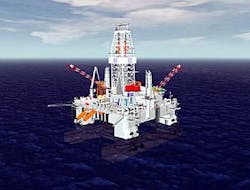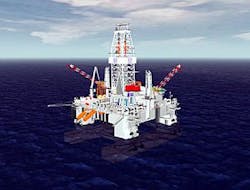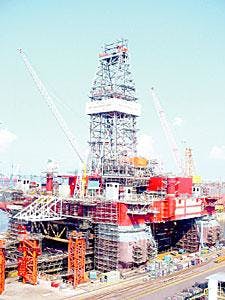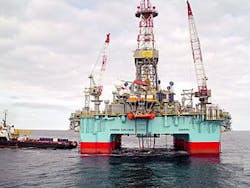Close to $1.6 billion have been invested in seven new mobile offshore drilling units that will be able to take advantage of recently rising rates in the deepwater rig market.
The new MODUs built in 2003-04 include six semisubmersibles and one drilling tender rig. One of the semis has already been completed in the Caspian Sea; another is under construction for the Caspian; two were completed in early 2004 in Portland, Me.; and two others are nearly complete in Singapore. The new drilling tender is under construction in Singapore with delivery planned for third-quarter 2005.
GSF Development Driller I & II
GlobalSantaFe Corp. will soon have two new ultradeepwater semisubmersibles, Development Driller I and II, joining its fleet of 9 semisubmersibles, 4 drillships, and 45 jack ups. The new rigs were commissioned Apr. 11, 2001, and have been under construction at the SembCorp Marine Ltd.'s Jurong Shipyard (JSPL), Singapore. The April agreement included the possibility of constructing two additional semisubmersibles.
The fifth-generation ExD design by Houston-based Friede & Goldman LLC includes 18,000 sq ft of usable deck space and more than 7,000 tonnes of variable deck load capacity, along with dynamic positioning and self-contained mooring systems (Fig. 1). The rigs will be capable of operating in 7,500-ft waters (OGJ, Sept. 20, 2004, p. 35).
Each of the Development Drillers will cost about $285 million, including equipment. The construction utilizes a new approach developed at Jurong and approved by the ABS, involving simultaneous construction of the upper and lower hulls followed by a skidding operation to join the two sections. The upper hulls, each weighing about 14,000 tonnes and measuring 8.6 m high and 75 m long and wide, were built on land over a reinforced skid truss connected to 12 skid shoes (Fig. 2). The drill floors and derricks were added before the mating. The lower hulls, each including two pairs of pontoons and columns, keel and truss, were laid in dry dock. The dry dock was then partially flooded to bring pontoons and columns up to the underside of the upper deck hull, according to ABS.
After the two parts of the hull were mated in an 11-hr process (Fig. 3), the emergency generator, helideck, flare booms, winches and cranes, remaining deck equipment, anchor bolsters, and moorings were installed at the Jurong yard.
The Development Driller I left the Singapore dock for the last time to install thrusters before sea trials (Fig. 4).
Development Driller I will be delivered first-quarter 2005. In April 2005, the rig will begin a 2-year contract with BHP Billiton Petroleum (Americas) Inc. in the Gulf of Mexico at a rate of about $210,000/day. The total contract is worth about $157 million.
Development Driller II will be delivered in second-quarter 2005. After a 3-month mobilization to the Gulf of Mexico, it will begin working on the Atlantis project in the Gulf of Mexico in early July 2005. The 3-year contract with BP PLC stipulates a rate of about $180,000/day.
The new rigs will sail under the flag of the Republic of Vanuatu, according to Rigzone.
Portland rigs
Final construction of two new semisubmersibles for Petrodrill Offshore Inc. was completed in Maine in spring 2004, by Pittsfield-based Cianbro Corp. under a $100 million contract, according to Rigzone. The Pride Rio De Janeiro left Portland harbor in February for Brazil, and the Pride Portland left in late June, according to local Portland reports. In November, the Pride Portland was ready-stacked off Curacao, according to Pride International Inc. Petrodrill is owned by Houston-based Pride (30%) and Brazilian partner Maritima Petroleo e Engenharia Ltda. (70%).
The two sister rigs are enhanced Amethyst fourth-generation design (Megathyst) by De Hoop, capable of drilling to 20,000 ft in 5,000 ft water depth, according to ODS-Petrodata and Scheepswerf De Hoop. The rigs are registered in Nassau, Bahamas, and were two of six ordered by Pride from three different yards in 1998, with the intention of chartering to Petrobras SA for 6-8 year terms (OGJ, Apr. 13, 1998, p. 38).
Construction of the two semisubs (Amethyst 4, 5) began in 1999 in Gulfport, Miss.-based Friede Goldman Halter Inc.'s yards in Pascagoula, Miss., and Orange, Tex. Work stopped on the rigs in May 2001 and about 900 workers were laid off, according to a May 11 article in The Telegram. FGH filed for bankruptcy Mar. 22, 2002, according to a Colton Co. position paper. From April to August 2002, the rigs were brought in pieces to the former Bath Iron Works pier in Portland under the contract with Cianbro (Fig. 5).
Cianbro was the first US company to use the floatover mating process for the 12,000-tonne rigs, in which the pontoons are submerged and the deckbox is moved onto the columns and welded in place, according to a company project synopsis.
Construction costs were estimated at $160 million/rig, in a July 1998 story by Alexander's Gas & Oil Connections. In October 2004, ODS Petrodata reported construction costs of $250 million for the Pride Portland.
Bangor Daily News reported in May 2004 that Petrodrill's project manager Derek Leach said, "These things should have cost less than $200 million to build. But that is nowhere near the cost because of the train wreck we had down south."
Pride-Foramer SA, a subsidiary of Pride International, will operate the rigs.
Caspian semisubmersibles
In 2003, Denmark's Maersk Contractors AS took delivery of a new deepwater fifth-generation semisub for the Caspian Sea. The rig was built after a contract was signed between Maersk, Exxon Azerbaijan Operating Co. (EAOC), and Chevron Overseas Operating Co. On Feb. 1, 2001, Maersk contracted with Keppel FELS and the Caspian Shipyard Co. to build the rig. Caspian Shipyard had previously constructed a jack up for the region, but this was to be the first semisub constructed in the Caspian, according to Keppel Annual Report 2003.
The semisubmersible rig with four rectangular columns is a DSS-20-CAS-M design by Marine Structure Consultants of Holland. The pontoons, upper columns, and rig floor substructure were fabricated at Keppel FELS yard in Singapore, and shipped to Azerbaijan. The 7,000-km journey took 45 days—Apr. 8–May 22, 2002—using two heavy-lift vessels: the Tern (carried pontoons), and the Wilma (carried the four columns and substructure).The topside modules were fabricated in Baku, and the rig was finally assembled at the Caspian Shipyard Co. in Azerbaijan. Total construction time was 31 months. Deck dimensions are 63.5 m long, 64.5 m wide, and 35 m from the pontoons to the top of the deck. The variable deck load capacity is 4,000 tonnes. The rig has a 2,000-hp National top drive, 4,000-hp National drawworks, and three 2,200 hp, 7,500-psi Wirth mud pumps.
The rig features state-of-the art environmental control systems and can accommodate up to 130 people, according to the American Bureau of Shipping.
In a ceremony in Baku on July 24, 2003, the rig was named Maersk Explorer and initially given the local name "Lider," meaning "leader" in Azeri (Fig. 6). Maersk told OGJ in November that the local name has been changed to "Heydar Aliyev." The Maersk Explorer can drill prospects in about 40% of the Caspian, as it can work in water 75-1,000 m deep and drill to 30,000 ft (OGJ, Nov. 17, 2003, p. 49).
In 2003, ABS classified the rig under an agreement with the Azerbaijani oil and gas safety agency Gosgortechnadzor (GGTN), responsible for offshore development in its sector of the Caspian Sea (OGJ Online, Aug. 24, 2004). The ABS describes the rig as "the most technologically advanced in the region."
In October 2003, the rig began working under a 3-year contract in the southern Caspian for a consortium consisting of Exxon Azerbaijan Operating Co. LLC, Chevron Overseas Petroleum Azerbaijan Ltd., the Azeri state oil company SOCAR, ConocoPhillips (UK) Ltd., and Total Exploration and Production Azerbaijan.
The Maersk Explorer operates under Danish flag, according to Rigzone.
National Iranian Oil Co. has the Khazar semisubmersible under construction in the Sadra Group's Caspian Sea Complex yard at Neka, Iran. The project was awarded in March 2001, and basic engineering design was provided by Sweden's GVA Consultants AB, according to project information posted by the Sadra Group. In late 2001, GVA-C was purchased by Halliburton Corp.'s KBR division, according to a Nov. 1 Halliburton press release.
The 15,000-ton Gotaverken GVA 4000 M design rig will be capable of working in 1,000 m water depth in the Caspian Sea. The estimated construction cost is about $226 million, and the rig is scheduled for delivery to NIOC in second-quarter 2005, according to ODS-Petrodata. Hamburg-based IMPaC Offshore Engineering GmbH provided project review and is supervising construction for NIOC.
Potential newbuilds
In discussing the booming market for deepwater rigs in its third-quarter 2004 report, Noble Corp. says it has four semisubmersible rig hulls available, three of which could be completed and brought into service within the next 5 years. These include the Noble Clyde Boudreaux, Noble Dave Beard, and two Bingo 9000-class bare deck hulls (Rigs 3, 4) currently at Cosco (Dalian) Shipyard Co. Ltd.'s yard in China. The Bingo 9000 rigs are DNV IAI column-stabilized design, similar to the Eirik Raude semisub built for Norway's Ocean Rig ASA (OGJ, May 17, 2004, p. 43).
In its third-quarter 2004 conference call, Noble said that it would not begin final construction on any of the rigs without a firm contract. With a contact in the next year and a half, the company says the Noble Clyde Boudreaux would be the first semisub into the yard and that it could be completed in 18-20 months for about $140 million. The Noble David Beard could be completed next, in 24-30 months for $225-275 million. The company estimates that a comparable newbuild would cost $400-450 million.
West Setia drilling tender
A new semisubmersible drilling tender (SSDT) has been under construction at Keppel FELS yard in Singapore this year, due for delivery in third-quarter 2005. The new West Setia is a six-column semi-tender using the new KFELS SSDT3600-GOM-C42 design with self-erecting column stabilizers. The design is similar to Smedvig's West Alliance, built in the same yard in 2001, for about $85 million (OGJ July 26, 2004, p. 43).
In April 2004, Smedvig ASA announced its agreement with Keppel Corp. to build the new semitender for a total cost of about $94 million. Smedvig will own the derrick and drilling equipment set (about $29 million) and Keppel will own the hull. Smedvig will manage and market the rig for 10 years and retains the right to purchase it for a preagreed price during that period.
Smedvig plans to use the West Setia for deepwater drilling operations adjacent to floating wellhead platforms (TLPs, spars) in calm waters.
Global market
The market for deepwater rigs has recently been rising. According to Rigzone, 80.2% of the world's semisubs were under contract in September (111 of 136), 69.2% of the world's drillships (23 of 32), and 70.8% of the drilling tenders (17 of 24).
In late October, the average contract rate for deepwater semisubs (4,000 ft or deeper) was about $116,000/day, and 43 of 50 were working as of Oct. 25. The average rate for midwater semisubs (1,500-4,000-ft waters) was slightly less than $74,000/day, with 65 of 87 working. The average rate for shallow-water semisubs (less than 1,500 ft water depth) was a little more than $59,000/day, with 14 of 29 working.
Only 5 of the 11 drillships capable of drilling in waters up to 4,000 ft deep were working, but 23 of the 27 deepwater drillships were under contract, at an average nearly $149,000/ day.
The average contract rate for drilling tenders was a bit more than $44,000/day at the end of October.
Semisubmersible rigs comprise about 29% of the global fleet of about 585 offshore drilling rigs. The majority (65%) are jack ups, while only 6% are drillships. According to ODS-Petrodata, in early November, the global supply of 226 floating rigs includes 163 semisubmersibles, 37 drillships, and 26 drilling tender rigs. Geographically, most semisubs are found in the Gulf of Mexico (18%; 29 rigs), off Brazil (13%; 22 rigs), West Africa (10%; 17 rigs), Mexico and Southeast Asia (7%; 12 rigs each).
Floaters have been mobilized to Mexico, Trinidad, and Brazil. As of early November, there were 10 deepwater rigs and 31 jack ups working in Mexico, 7 jack ups and 1 semisubmersible working off Trinidad. Brazil had 22 semisubs, 11 drillships, and 5 jack ups working, second in the Americas only to the Gulf of Mexico (29 semisubs, 8 drillships, 86 jackups).
In Brazil, the Noble Roger Eason drillship began a 700-day contract for Petrobras in November at $96,250/ day. Noble also operates two other deepwater drillships (Noble Leo Segerius, Noble Muravlenko) and one deepwater semisubmersible (Noble Paul Wolff) off Brazil.
Semisubmersibles now comprise about 55% of rigs in the North Sea market. From nearly 70 rigs in the North Sea in 1991, the supply has dropped to 40 in 2004, with utilization around 55%. Day rates for North Sea semisubs have dropped to about $90,000/day in first-quarter 2004 from about $176,000/day in 1998.
As major operators reduce their activities and fields are taken over by independents, demand for floaters in the North Sea will likely remain at current levels, if not drop. Amerada Hess UK Ltd., BP PLC, ConocoPhillips UK Ltd., Marathon Oil Corp., Murphy Oil Corp., and Royal Dutch/ Shell have all divested North Sea properties in the past 2 years.
The fields and facilities have been picked up by Apache North Sea Ltd. ($737 million); Perenco ($162 million); Burlington Resources Inc. ($100 million); Canadian Natural Resources Ltd. ($96 million); Talisman Energy UK Ltd. ($90 million+); Venture Production PLC ($28 million); and others.
Offshore drillers in the North Sea are GlobalSantaFe Corp., Noble, and Transocean.
The market for floaters in West Africa has improved quite a bit since 1995, to 24 in fourth-quarter 2004 from 11 rigs in early 1995, but remains less than the possible project opportunities. About half the rigs now used offshore are floaters, with semisubs taking 33% of the market, drillships about 11%, and tenders about 9%, according to Rig Zone. Day rates for floaters in West Africa have also improved, from about $45,000/day in third-quarter 1995 to nearly $140,000/day in first-quarter 2004.
This year, semisubs were operating off Angola (for BP,.Cabinda Gulf Oil Co., and ExxonMobil) and Nigeria (ExxonMobil; Noble Homer Ferrington). Total SA expects to drill off Nigeria in 2005. A drilling tender was used by Cabinda Gulf in Angola, and CNR International UK Ltd. expects to use one for drilling off Ivory Coast in April 2005. Drillships are under contract by ChevronTexaco Corp., Devon Energy Corp., ConocoPhillips, ExxonMobil, Royal Dutch Shell, and ENI UK Ltd. for work off Nigeria. Nexen Petroleum Inc. began drilling the Zorro prospect in deepwater Block K off Equitorial Guinea in October, and BP will use a drillship off Angola in January 2005.
Drilling contractors providing floaters to the Southeast Asia market include Atwood Oceanics Inc., Diamond Offshore, GlobalSantaFe, and Transocean.
Domestic market
The supply of floaters in the Gulf of Mexico has dropped to only 37 in third-quarter 2004 from a high of 51 rigs in late 2001. The demand for floaters in the Gulf of Mexico has been depressed, with only 22 semisubs and 6 drillships under contract as of Nov. 9, 2004, and utilization at 76%.
Deepwater drillers in the Gulf of Mexico are predominantly Transocean Inc. (6 drillships, 7 semisubs), Diamond Offshore Drilling Inc. (12 semisubs), and Noble Corp. (4 fourth-generation; 2 second-generation semisubs).
Average rates dropped from near $190,000/day in January 1998 to less than $90,000/day in first-quarter 2004, but Noble anticipates rates for fourth-generation semisubs rising to $130,000-160,000/day in 2005. The company said its average domestic rate for deepwater semisubs rose more than 10% to $106,880/day in third-quarter 2005, up from $96,727 in second quarter. The company operates six deepwater semisubmersibles in the Gulf of Mexico.
Earlier in the year, Raymond James analysts predicted weak to deteriorating deepwater markets in the Gulf of Mexico, North Sea, and South America, a slowly improving to stable market for floaters off West Africa, and strong markets in Southeast Asia, Indian Ocean, Trinidad, and perhaps Mexico. They noted that "semisubmersible newbuild economics suggest day rates need to be $250,000" before building would commence on any new units.
Lehman Bros. analyst and Vice-Pres. Angeline M. Sedita said in a late October research note that "a peak scenario for the global deepwater market is now much closer, given the recent and marked improvement in the worldwide deepwater market."








